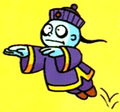Pionpi: Difference between revisions
mNo edit summary |
m (had to —> must; was —> is) |
||
| Line 4: | Line 4: | ||
|related=[[Dry Bones]] | |related=[[Dry Bones]] | ||
}} | }} | ||
'''Pionpi'''<ref>''Super Mario Land'' English instruction booklet, page 17.</ref>, also known as '''Pinopi'''<ref>The Nintendo ''Game Boy'' Player's Guide, page 5.</ref>, are zombie-like enemies found in ''[[Super Mario Land]]''. They are based on [[wikipedia:Jiangshi|Jiangshi]], a mythical vampire and zombie-like creature supposedly originating from Chinese folklore. Found in the [[Chai Kingdom]], they will constantly try to [[jump]] on [[Mario]]. They can be temporarily stunned by being jumped on, which will also award Mario with 800 points. To actually destroy them, Mario | '''Pionpi'''<ref>''Super Mario Land'' English instruction booklet, page 17.</ref>, also known as '''Pinopi'''<ref>The Nintendo ''Game Boy'' Player's Guide, page 5.</ref>, are zombie-like enemies found in ''[[Super Mario Land]]''. They are based on [[wikipedia:Jiangshi|Jiangshi]], a mythical vampire and zombie-like creature supposedly originating from Chinese folklore. Found in the [[Chai Kingdom]], they will constantly try to [[jump]] on [[Mario]]. They can be temporarily stunned by being jumped on, which will also award Mario with 800 points. To actually destroy them, Mario must lure them off the level or shoot them with two [[Superball Mario|Superball]]s. They are similar to [[Dry Bones]], being an undead enemy that soon resurrects upon being squashed. | ||
In the ''Game Boy'' comics published by [[Valiant Comics]], a Pionpi | In the ''Game Boy'' comics published by [[Valiant Comics]], a Pionpi is shown to be [[Tatanga]]'s second-in-command and frequently rides around on a [[Yurarin Boo]]. In the issue "Team Play", this Pionpi leads Tatanga's invasion of the Great Wall of China and is also the only one of Tatanga's Elite Squadron to protest [[Herman Smirch]]'s joining of Tatanga's forces. | ||
==Profiles== | ==Profiles== | ||
Revision as of 13:46, March 14, 2020
Template:Species-infobox Pionpi[1], also known as Pinopi[2], are zombie-like enemies found in Super Mario Land. They are based on Jiangshi, a mythical vampire and zombie-like creature supposedly originating from Chinese folklore. Found in the Chai Kingdom, they will constantly try to jump on Mario. They can be temporarily stunned by being jumped on, which will also award Mario with 800 points. To actually destroy them, Mario must lure them off the level or shoot them with two Superballs. They are similar to Dry Bones, being an undead enemy that soon resurrects upon being squashed.
In the Game Boy comics published by Valiant Comics, a Pionpi is shown to be Tatanga's second-in-command and frequently rides around on a Yurarin Boo. In the issue "Team Play", this Pionpi leads Tatanga's invasion of the Great Wall of China and is also the only one of Tatanga's Elite Squadron to protest Herman Smirch's joining of Tatanga's forces.
Profiles
Super Mario Land
- 3DS Virtual Console manual: "Hopping about persistently, Pionpi keeps coming back to life no matter how many times Mario jumps on him. He can be defeated by a Superball."
Gallery
Names in other languages
| Language | Name | Meaning |
|---|---|---|
| Japanese | ピョンピー[3] Pyonpī |
From pyonpyon, a mimetic word for hopping. Also a pun on Jiangshi's Japanese pronunciation, kyonshī. |
| German | Pionpi |
Pionpi |
| Spanish | Pionpi |
Pionpi |
References
| Super Mario Land | |
|---|---|
| Protagonists | Mario • Princess Daisy |
| Bosses | King Totomesu • Dragonzamasu (Tamao) • Hiyoihoi • Biokinton (Chicken) • Tatanga (Pagosu) |
| Locations | Sarasaland (Birabuto Kingdom • Muda Kingdom • Easton Kingdom • Chai Kingdom) |
| Levels | World 1-1 • World 1-2 • World 1-3 • World 2-1 • World 2-2 • World 2-3 • World 3-1 • World 3-2 • World 3-3 • World 4-1 • World 4-2 • World 4-3 • Expert Level |
| Items & vehicles | Super Mushroom • Superball Flower • Star • 1UP heart • Coin • Marine Pop • Sky Pop • Switch • Lift Block |
| Enemies & obstacles | Batadon • Bombshell Koopa • Bullet Biff • Bunbun • Chikako • Dropping lift • Falling block • Falling spike • Fly • Ganchan • Gao • Gunion • Goombo • Honen • Kumo • Mekabon • Nyololin • Pionpi • Pipe Fist • Piranha Plant • Pompon Flower • Roketon • Roto Disc • Suu • Tokotoko • Torion • Yurarin • Yurarin Boo |
| Other | Brick • Bonus game • Das Super Mario Spiel • Gallery • Glitches • Goal • Media • Mystery Block • Soundtrack |
